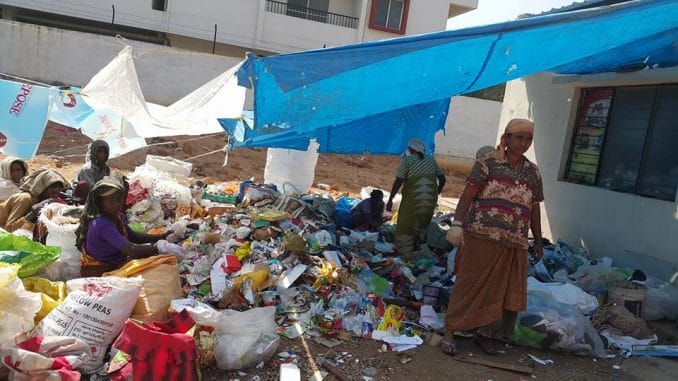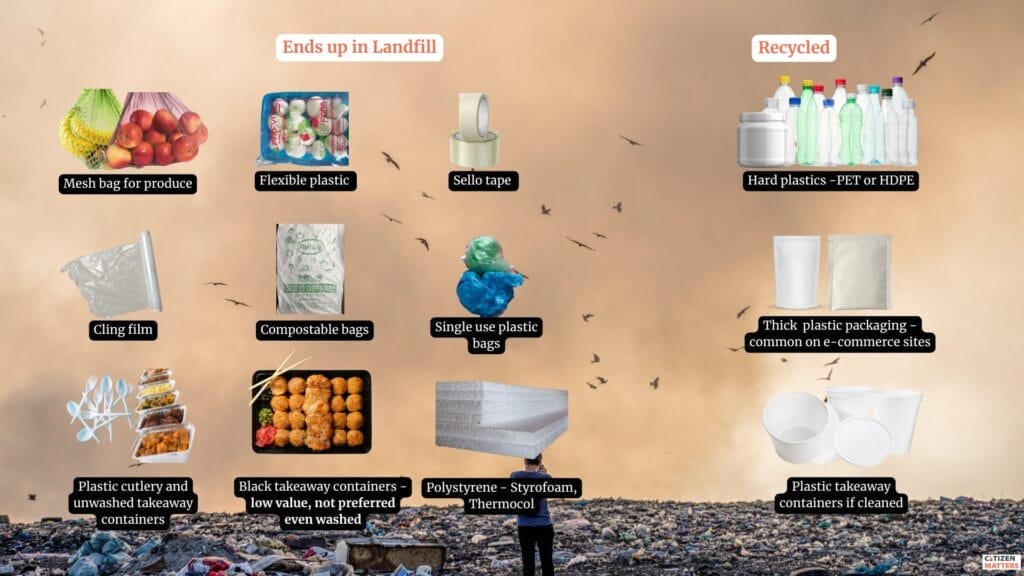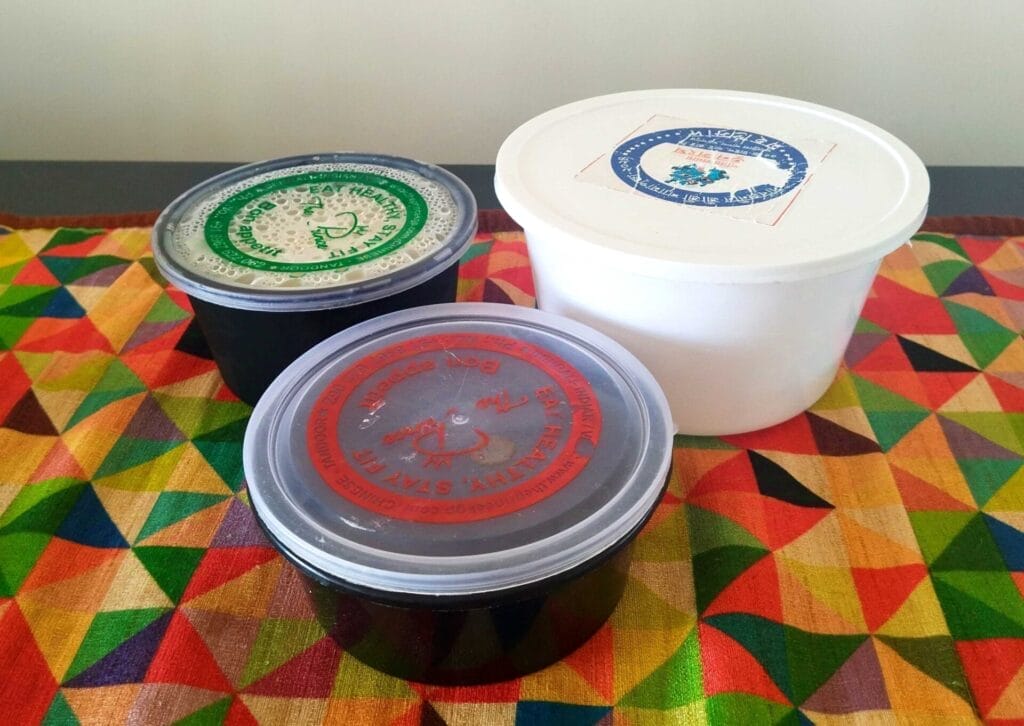Anjana S, a Bengaluru-based software engineer, estimates that e-commerce companies deliver at her doorstep at least 15 times a month. “I place orders with companies like Flipkart 2-5 times a month. And grocery orders with quick delivery companies, like Zepto, 3-4 times a week,” she says. Which leaves her with considerable packaging material, often plastic, that she has to dispose of.
Like many Bengalureans, Anjana works out of home and rarely frequents retail shops these days. The discounts offered by e-commerce companies are more attractive as well. “Some platforms also waive the delivery fee if I buy a monthly pass,” she says, adding that most residents in her apartment complex now order from e-commerce companies. She tries to reduce packaging waste by using sustainable options offered by these companies – such as combining deliveries and avoiding plastic cutlery, but acknowledges that her dry waste generation is still quite high.
Another consumer Lisha L P says her household has 1-2 sacks of plastic and paper packaging waste every month from online shopping.
With the growing popularity of e-commerce companies, waste collectors and processors in Bengaluru and Chennai are grappling with a massive rise in packaging waste. Indumathi, in charge of three dry waste collection centres (DWCCs) — Bellandur, Jeevan Bima Nagar and KR Puram — in Bengaluru, says packaging waste from e-commerce companies has risen manifold since 2017. “In 2017, this made up 3-4% of the dry waste coming in. Now it is 10-15%.”

Within this waste, two-thirds are plastic containers delivered by food delivery platforms, she estimates. The rest are low-density polyethylene (LDPE) covers, polystyrene (thermocol/styrofoam), cardboard boxes, paper packaging, etc. Indumathi works under Hasiru Dala, a social enterprise that operates DWCCs in a fifth of Bengaluru corporation’s wards.
Krishnapriya A, co-founder of the Chennai-based waste management company Spreco Recycling, says, “Packaging waste is increasing; there is no downward trend, especially as newer companies are entering the e-commerce segment.” Consumers’ increased use of e-commerce platforms since COVID is another reason.
Read more: What would it take to make eco-friendly packaging pocket-friendly too?
Self declared data by generators
Shafeeq Ahmed Syed Ali and Dr Saman Ilankoon of Monash University Malaysia, who co-authored a paper on packaging waste from India’s e-commerce sector, point out that India is currently the eighth largest global market for e-commerce. Parallelly, India’s packaging sector is also growing rapidly, and is expected to be valued at 240 billion USD by 2025.
However, no agency in India tracks the extent of packaging waste from e-commerce companies. The industry is estimated to have generated 98,000 tonnes of plastic packaging waste in 2021. This was a three quarters increase compared to the 2020 numbers.
Data from the national EPR (Extended Producer Responsibility) portal under the Central Pollution Control Board, indicates that Amazon India declared the introduction of 17,643 tonnes of plastic waste into the market since the launch of the EPR portal in 2022. Similarly, Flipkart declared 16,639 tonnes. Zomato Hyperpure – a Zomato company that supplies groceries only to restaurants – introduced 2,285 tonnes. (These numbers are based on the reporter’s calculations using the recycling targets declared by the companies on the EPR portal.)
A Flipkart spokesperson responded to our queries, saying that the company now uses only recyclable packaging material in its own supply chain (excluding third-party sellers). “We have also eliminated secondary plastic packaging (additional plastic packaging over the product’s existing packaging) at our warehouses and for our ‘Fulfilled by Flipkart’ deliveries.” The spokesperson added that the company has been engaging with third-party sellers to reduce their plastic generation.
Large proportions of packaging waste are not recycled
A fifth of all packaging plastics produced in India are estimated to be littered or openly burnt, as the majority is short-life packaging.

In the last few years, some e-commerce companies have attempted to reduce plastic packaging waste by replacing plastic with paper to some extent, allowing consumers to opt out of using plastic covers, etc. But plastic packaging continues to be used in many forms – thick plastic covers for products, polystyrene or bubble wrap for delicate shipments, clip wrap and plastic net/mesh for fruits/vegetables, compostable bags for groceries, plastic containers for food, and so on.
Many consumers believe packaging waste is recyclable. But in reality, a large proportion ends up in landfills or in the city’s trash heaps.
Bianca Fernandes, IEC manager and policy advocate at Hasiru Dala in Bengaluru, says, “The mesh used to cover vegetables have no recycling value, and don’t get recycled. Delivery packets from companies like Amazon are recyclable, but they come with a lot of cellotape and stickers which workers find hard to remove. The cellotapes themselves are not recyclable either.”
She adds that compostable bags, commonly used by some grocery delivery companies, also end up with reject waste as they are neither recyclable nor directly compostable.
The biggest challenge for waste workers though, are plastic food containers that are ubiquitous now. “The white-coloured food boxes have good recycling value, they fetch Rs 20 per kg. But many people hand these over after 3-4 days, without washing, and the food would have rotted by then,” says Indumathi of Hasiru Dala.
Bianca adds,“Such boxes often have maggots, and DWCCs have no infrastructure to clean them. So these boxes too go into reject.”
Waste workers also generally don’t prefer black-coloured food containers that are difficult to recycle, as these fetch only Rs 6 per kg.
Krishnapriya of Spreco Recycling adds to the list of e-commerce packaging that don’t get recycled: “Consumers often cut through the plastic net used to wrap vegetables, so waste pickers don’t pick these up. Cling wrap and flexible boxes (like those used to pack mushrooms) are difficult to recycle.”
Krishnapriya also points out that among plastics in general, hard plastics such as PET (Polyethylene terephthalate) and HDPE (High Density Polyethylene) — usually used to make water bottles, product containers, etc — are the most recycled. “The plastic boxes they use may be PET or PP (polypropylene), which can be recycled if collected and segregated properly. But in e-commerce packaging, the volume of low-value material is higher, such as plastic covers and nets,” she says.

Poor labelling also poses a challenge. Krishnapriya explains that the law mandates plastic manufacturers to label boxes, mentioning the type of plastic used, but most just put the recycling symbol. “Or they just mention the type of plastic as ‘Other’, which means it could be a blend of multiple types of plastic. These are hard to recycle because they are difficult to sort either using technology or even manpower.” In such cases, recyclers have to rely on manual float or flame tests to identify the type of plastic used.
“Recycling would be much easier if every e-commerce company at least uses standardised plastic boxes of the same material,” says Krishnapriya.
Cities far from recycling
Hasiru Dala’s DWCCs segregate waste into 38 categories. They send the recyclables to the respective buyers, while BBMP picks up the reject waste which usually ends up in the latter’s waste-to-energy plants or landfills.
Not all BBMP wards have dry waste collection centres either; in such cases, BBMP’s waste collectors are supposed to segregate waste. But in many parts of the city, they continue to collect mixed waste.
Bengaluru is estimated to generate about 5,000 tonnes of waste every day, of which over half are disposed of in landfills without any processing.
In Chennai too, the gaps are huge. Vamsi Shankar Kapilavai, Senior Researcher at the NGO Citizen consumer and civic Action Group (CAG), points out that less than a tenth of the city’s waste gets processed. “Chennai generates over 7,000 tonnes of waste daily now. The city has the capacity to process 2,460 tonnes of waste only, but even this capacity is not utilised. According to the Chennai Climate Action Plan report, only 637 tonnes is actually processed.”
Read more: Much of the segregated dry waste in Mumbai ends up in landfills; here’s why
A coalition of 60 “high ambition” nations have convened in South Korea this week to discuss policy measures to curb plastic production in order to end the global menace of plastic pollution. But till we achieve any meaningful success in terms of an agreement on production curbs among a critical mass of nations, it is clear that we have a lot to do on the management of all the packaging waste that our e-commerce-inclined cities are ending up with.
It is crucial for brand owners and e-commerce companies to own responsibility for the entire life cycle of plastics they generate. It is as important for consumers to make responsible choices and manage the waste effectively. Why, and what that entails, is what we shall look at in a follow-up to this article.